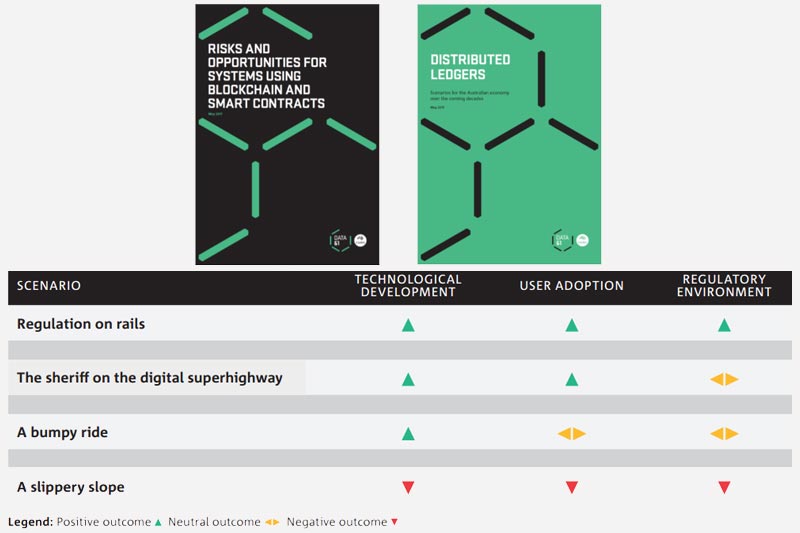
Image credit: Data61
The Commonwealth Scientific and Industrial Research Organisation’s data innovation unit Data61 has released two reports on long term scenarios involving Blockchain or Distributed Ledger Technology (DLT) and immediate technical applications. These reports were funded under the National Innovation and Science Agenda.
The first report, ‘Distributed Ledgers: Scenarios for the Australian economy over the coming decades’, explores four plausible adoption scenarios of Blockchain technology in Australia in 2030.
The study contains analysis, interpretation and foresight, created by Data61 in consultation with subject-matter experts, in order to inform government, industry, and the broader Australian community of the plausible implications of DLT.
It notes that the Blockchain is not a silver bullet, and has limitations that should be considered before and during the design and development of new systems. For example, the report expects the processing of transactions to ultimately transition to a commission-based (user pays) scheme. In the end this loss of the provision of new Bitcoins to miners may reveal the currently hidden transaction costs of the system, increase transaction costs (commissions) and disrupt the market that has formed by removing a competitive advantage and making it less attractive than the regulated market. The potentially uneven introduction of advanced computing processing power, such as quantum computing, is another example of potential disruption for this technology.
The scalability of Blockchain currently is limited. High transaction demands may choke a system on its own popularity. Carefully employing Blockchains for specific roles, such as the management of identity, content, or transactions inside larger distributed ledgers might be better option for optimising outcomes.
This integration is challenged by the current lack of agreed definitions and is generating confusion as key concepts are becoming lost in translation between domains. For example, the report states that ‘smart contracts’ are arguably neither smart, nor contracts, and the use of the term could imply assurances of functionality it does not have.
It also highlights the complexity of integrating cross-domain knowledge for Blockchains. The permanence and persistence of new distributed ledgers also present challenges and risks that are novel in information systems. Potential privacy challenges would require good designs and good governance for prevention and management.
Regulation on rails, aspirational scenario
This is a future where governments and the public sector have recognised the risks and potential of emerging technologies and provided leadership by embracing a cohesive regulatory regime that supports and leverages them. Distributed ledgers are employed to increase trust in government activities through identity management, fraud control, programmable money/transactions (smart contracts), and regtech.
There have been significant improvements in productivity through high levels of regulatory support and regulatory automation, private and public sector adoption and technological innovation and development.
The Sheriff on the Digital Superhighway, transformational scenario
In this scenario Data61 imagines a future where industry adopts a leadership role in the adoption of the Internet of Things (IoT) and distributed ledger technology. The IoT has continued on its projected exponential growth curve and is in part responsible for a similar growth in the amount of data being generated.
Industry standards and DLTs are used to manage the cyber security and data provenance problem created by the intersection of these two growth trends. DLTs basically act as the sheriff, enabling the creation of an internet of trust and increasing productivity.
A Bumpy Ride, new equilibrium scenario
In this scenario the the market is left to its own devices. There is no leadership or industry guidelines or standards. DLTs proliferate, and compete with each other and more traditional financial products that enjoy a renaissance.
But the lack of standards and regulation leaves the public with a sense of uncertainty in the quality, longevity and credibility of these products. Lack of trust from users and industry means the pathway to the productivity potential of this technology is not smooth.
A Slippery Slope, collapse scenario
In this scenario a future Australia is imagined with a regulatory environment and user-base hostile to distributed ledgers through broken trust. Some technological innovations had occurred but their implementations were not aligned with the appetites or expectations of investors and users.
Developments which could contribute to this kind of scenario include Insurance oracles specified in the ‘smart contracts’ and the ‘smart contracts’ themselves being found to have been rigged against claims or Public distributed ledgers having sensitive and deeply personal information registered on them with no way of restoring the victims’ privacy or retrieving and retracting the information.
The second report, ‘Risks and opportunities for systems using Blockchain and smart contracts’. The report makes a number of recommendations. For example, it says that regulators and enterprise should be technologically neutral in framing the criteria for acceptance of a system in their domain. In other words, there should be no regulation nor prohibition for blockchain technology specifically, even for public blockchains.
It says that even in highly-regulated industries, public Blockchain systems may be appropriate for use for some limited purposes, such as public announcements, product catalogues, software update checking, or fully-public government registries. It also recommends that field trials of Blockchain-based systems should demonstrate responses to ‘rainy day scenarios’ arising from both anticipated and unanticipated problems in the use of those systems.
The report lists a variety of applications of Blockchain technology within financial services, government and enterprise and industry. Financial services applications include digital currency, (International) payments (often via digital currency on a Blockchain, with local exchanges between the digital currency and fiat currencies), reconciliation for correspondent banking (so that reciprocal nostro/vostro accounts held between two banks are replaced by a single shared ledger) and securities registration, clearing and settlement.
Smart contracts on Blockchains can provide a platform for making and accepting offers to trade assets or services. The Blockchain will record the status of these trade offers. Individual smart contracts could themselves carry the digital currency required to be paid on fulfilment of these offers. This functions as a kind of escrow, without the need for a trusted third party organisation. However, Blockchains are not suitable for high-frequency (low latency) market trading.
In Trade finance, Blockchain could be used to evidence trade-related documents in order to reduce lending risk and improve access to finance for industry. Smart contracts could control inter-organisational process execution, and transparently automate delayed or instalment payments.
Blockchains could enable improved government service delivery, and private Blockchains could be used to facilitate information sharing and process coordination across agencies within government. Application areas being explored in governments globally include Registries and identity (including the identities and attributes of persons, companies, or devices; licensing; qualifications; and certifications), grants and social security (automating the process coordination to apply for, decide on, and distribute payments for grants and social security), quota management (government-granted quotas, allocations, and rights to physical resources) and taxation.
The report states that the full potential of Blockchain technology is likely to be realised outside financial services and government. Blockchains are a foundational horizontal platform technology that could be used in any industrial sector including agriculture, utilities, mining, manufacturing, retail, transport, tourism, education, media, healthcare, and the sharing/P2P economy.
Supply chains form an excellent use case. Blockchain technology can be used for tracking physical assets through changes in ownership and handling. This implicitly creates provenance information for goods, and provides improved logistics visibility and supply chain quality. Key events within the supply chain could be linked to automatic payments with the use of smart contracts.
Internet of Things (IoT) storage, compute, and management devices connected to the internet can use the Blockchain as a persistent and highly-available storage solution, can use smart contracts to provide a global distributed computing capability, and can rely on the Blockchain as a secure channel for receiving information about software and configuration updates and dynamically-delegated access control (including physical access control, for locking devices).
Blockchain can create a metadata layer for decentralised data sharing and analytics. Although large datasets themselves are unlikely to be stored there, a Blockchain can help to discover and integrate those datasets and data analytics services).
There are other potential applications in the areas of digital rights and IP management, attestation and proof of existence, inter-divisional accounting and corporate affairs, such as board and shareholder voting and registrations.
The study goes on to select three use cases to examine how Blockchain systems can support new markets and business models. These include: agricultural supply chains, government registries and remittance payments. The report provides a non-exhaustive list of reasonable but simple high-level solution designs in these three use cases, revealing some aspects of the technical risks and opportunities for Blockchain technologies.
Access the reports below:
Distributed Ledgers: Scenarios for the Australian economy over the coming decades
Risks and opportunities for systems using Blockchain and smart contracts
















